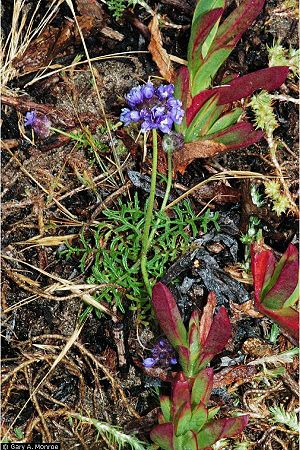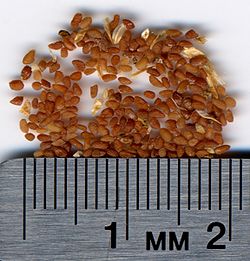Difference between revisions of "Gilia capitata"
(→References) |
|||
| Line 78: | Line 78: | ||
===References=== | ===References=== | ||
| − | <References | + | <References> |
[http://plants.usda.gov/java/profile?symbol=GICA5| USDA plant profile] <br> | [http://plants.usda.gov/java/profile?symbol=GICA5| USDA plant profile] <br> | ||
| − | [http://en.wikipedia.org/wiki/Gilia_capitata| GICA Wikipedia] | + | [http://en.wikipedia.org/wiki/Gilia_capitata| GICA Wikipedia] <br> |
| + | [http://biology.burke.washington.edu/herbarium/imagecollection.php| Burke Herbarium] <br> | ||
| + | [http://www.wildflower.org/plants/result.php?id_plant=GICA5| Wildflower.org] | ||
| + | MacKinnon, Andy, and Jim Pojar. Plants of the Pacific Northwest coast. Lone Pine Pub, 2004. Print. | ||
| + | <References/> | ||
{{Basics}} | {{Basics}} | ||
Revision as of 11:24, 30 April 2012
Gilia capitata also known as Blue gilia, Blue thimble flower, Globe gilia, Blue-head-gily-flower is in the Polemoniaceae family.
Contents
Taxonomy
- Kingdom: Plantae
- (unranked): Angiosperms
- (unranked): Eudicots
- (unranked): Asterids
- Order: Ericales
- Family: Polemoniaceae
- Genus: Gilia
- Species: G. capitata
Description
- General: Erect, slender, sparingly-branched annual, the glabrous to stipitate-glandular stem 1.5-10 dm. tall.
- Leaves: Leaves basal and cauline, the lower bipinnatifid with slender rachis and narrow ultimate segments; reduced upward and becoming pinnatifid.
- Flowers: Flowers sessile in dense, 50- to 100-flowered heads terminating the stem and branches; corolla bluish, 6-10 mm. long, the 5 slender lobes about equaling the tube; calyx with prominent translucent intervals between the 5 herbaceous segments; filaments inserted in the sinuses of the corolla, about equal to the lobes; style 3-parted; ovary superior.
- Fruit: Capsules with 3 carpels, each with 2, 3 or 0 seeds; become mucilaginous when wet.
Bloom Period
May, June, July
Distribution
More common west of the Cascade summits,Vancouver Island, British Columbia, to California, east to Idaho
Habitat
Fairly common in dry to moist open meadows, rock outcrops, rocky slopes, clearings, and roadsides, at low to middle elevation; escaped from cultivation and established in a few places in southeast Alaska
Uses
Propagation
Seeds may be sown from autumn to early spring, but germination is better when planted with autumn rains. Self-sows readily
Seed
Abbreviation: GICA
Seed sample from: 2011
Average Measurement: 1.7 x 1.1 x 0.7
Measurement Range: L: 1.2 – 2, W: 0.75 – 1.4, D: 0.5 – 1.1
Features
Shape: Seed narrow at hilium end, broadening at opposite apex. Hilium inconspicuous. Uniformity in shape is not that common, but most seeds take a relatively teardrop shaped.
Color: Seed is brown, very bumpy, and slightly lustrous.
Surface: Seed coat becomes very mucilaginous and stringy when wet.
Could be confused with COGRX, but GICA is about ½ the size and does not have sulcus.
Latitudinal Cross Section: elliptical ![]()
Longitudinal Cross Section: obovate ![]()






